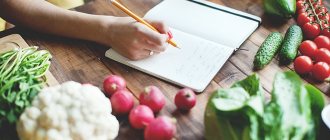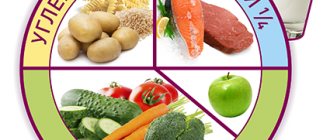The key to the harmonious mental and physical development of a child, among other things, is proper and balanced nutrition. And if in the first months of life this is mainly due to breast milk or artificial formula, then as soon as the baby turns 1 year old, his diet changes radically. Some parents prefer to switch it to an “adult” diet, while others assign the main role to breast milk or formula, using “adult” dishes only as complementary foods. Both strategies have a right to exist. The main thing is to study the physiological characteristics of the child’s body in advance, apply basic nutritional principles and follow the pediatrician’s recommendations. This is exactly what we will talk about in the article.
General recommendations
Usually a one-year-old baby eats 4-5 times a day. Snacks with milk between main meals are possible, but it is better to gradually eliminate them, creating a daily routine that will help the child adapt more easily to kindergarten.
On average, at the age of 1 to 1.5 years, a baby eats 1100 - 1200 ml of food:
- Breakfast – 275-300 ml;
- Lunch – 385-420 ml;
- Afternoon snack – 165-180 ml;
- Dinner – 275-400 ml.
Pediatricians advise including cereals, vegetables, fruits, fish, meat, eggs, and dairy products in the menu of a 1-year-old child.
Each of these products contains nutrients and minerals necessary for the growth of a child:
- Cereal porridges are rich in carbohydrates, vegetable proteins, minerals, and vitamins.
- Meat contains proteins, amino acids, iron, and vitamins necessary for growth and development.
- Fish is well digestible, it contains vitamins, minerals, and the omega-3 component necessary for normal brain function. Giving fish to children must be done very carefully to avoid possible allergic reactions.
- Your daily menu must include fruits and vegetables. They contain many vitamins and fiber. If you are not particularly sensitive to them, they can be eaten raw, steamed or boiled.
- Dairy products remain an important component of a 1-year-old child's diet. They contain proteins that are absorbed most fully by the child’s body, fats, carbohydrates, and calcium. Fermented milk products contain beneficial bacteria necessary for intestinal function. The use of dairy products should be limited if the child has lactose intolerance.
- Eggs can be one of the factors that provoke allergies. But if the baby does not have an allergic reaction, then there is no reason not to give them. A 1 year old child's diet can include 1.5 eggs per week. Eggs contain easily digestible protein and various microelements.
- Nothing bad will happen if you include a little white bread, jam, marmalade, and marshmallows made from natural products without added sugar in your baby’s diet.
- Weak tea and boiled water are perfect to quench your thirst. You just have to remember that it is unlikely that a one-year-old child will be able to say that he is thirsty. It is better to always keep a bottle of clean water so that the baby can reach it.
It is better not to include salt and sugar in your food. He will still have time to get used to these products in kindergarten and when he grows up.
general information
Nutrition plays an important role in the development of the body and mental activity.
By consuming only proper and healthy food, the child will be protected from the negative effects of the environment. Compared to the body of an adult, a child develops at a rapid pace, which requires much more energy. Therefore, he needs high-quality food products, which the body must receive in a timely manner. Otherwise, various problems may occur: retarded growth and development, frequent illnesses.
What to do with your baby
Often the mother of a one-year-old child does not yet work or works remotely and can devote more time to her baby. This doesn't mean she has time to cook different dishes. The child constantly tries to climb into her arms. But cooking the same dish is neither interesting nor healthy. The cooking process will go faster if you create a menu for a 1-year-old child with recipes for a week at once.
Many mothers try to cook food with their baby, sitting him on a high chair, giving him a piece of dough, berries, bran, peas.
From all these products you can come up with a game that will distract the child’s attention for a while. And at this time the mother will take out the ingredients from which the food will be prepared and begin to cook. At the same time, he will tell a fairy tale about peas that ran away from an evil old woman, or berries that the good girl Masha collected in a basket. Plots for fairy tales are limited only by mother's imagination.
Cooking features
The first rule is that heat treatment must be optimal. Undercooked meat is a source of a variety of infections, but overcooked vegetables are practically devoid of nutrients. Therefore, it is important to follow the recommended duration of baking, boiling and stewing. Remember, the more vegetables are chopped, the less vitamins remain in them.
If possible, cook immediately before meals. Storing prepared meals in the refrigerator reduces their nutritional value. The maximum permissible storage period is 1 day.
As for chopping, after a year you need to focus on the child. If he has several teeth and is ready to chew, you now need to slowly increase the size of the pieces. We no longer chop vegetables in a blender, but chop them with a fork. We prepare meat and fish in the form of minced meat, from which we prepare souffles, meatballs, cutlets and zrazy.
As before, we only add a pinch of salt, and the only seasonings allowed are dill, cilantro and parsley.
Breakfast
Bearing in mind that the baby needs to follow a daily routine, it is better to start breakfast at 8:30. Before this time, it is advisable to have time to wash your face, brush your teeth and do exercises. The breakfast menu usually includes porridge and milk soups. Some recipes are presented below.
Porridge with milk, zucchini and apple
Ingredients:
- Hercules - 1 glass;
- Skim milk – 1 glass;
- Water – 3 glasses;
- Apple – 1 (preferably green);
- Zucchini (200 g).
Grind the zucchini and apple. Place the resulting gruel and rolled oats into milk and water. Cook in a multicooker on the “milk porridge” mode or in a saucepan.
Rice porrige
Ingredients:
- Milk – 200 ml;
- White rice – 1 tbsp. l.;
- Butter – 5 g;
- Pear is a small piece.
Bring the milk to a boil and add rice to it. Cook over medium heat for 25 minutes. The grains need to become soft. If necessary, you can mash them a little with a fork.
You can cook rice in water and add 2-3 tablespoons of milk only at the end of cooking. Before serving, garnish the porridge with pear slices.
Wheat porridge with jam
Ingredients:
- Milk – 200 ml;
- Wheat grits – 1 tbsp;
- Butter – 5 g;
- Jam – 1 tsp.
Boil the milk, add the washed cereal and cook over low heat for about 20 minutes. Once cooking is complete, add jam. It can be stirred evenly into the porridge or laid out in a pattern on its surface. Add butter.
Milk soup with noodles
Ingredients:
- Vermicelli – 1 tbsp. l.;
- Milk – 1 glass;
- Water - half a glass;
- Butter - half a tsp.
Boil water in a saucepan, put the vermicelli in it, cook until tender, drain in a colander, and let the water drain. Boil milk, add vermicelli and cook for another couple of minutes. Fill with oil.
To make the child interested in porridge or soup, dishes can be decorated with raisins and pieces of fruit.
Vegetarianism: is it suitable for children?
Some parents who do not eat meat try to instill the same eating habit in their children. At the same time, vegetarians claim that protein, the main source of essential amino acids, can also be obtained by consuming legumes.
But that's not true. Plant foods do not contain essential amino acids, which are found exclusively in foods of animal origin.
The children's diet should contain at least 50% protein of animal origin. If there is insufficient intake of it into the child’s body, the following problems may arise:
- development of iron deficiency anemia;
- slowdown in the physical development of the baby;
- weakened immunity;
- insufficient absorption of calcium, which leads to late rickets, bone weakness and subsequent bowing of the legs under the weight of one’s own body;
- impaired contractility of the heart due to myocardial weakness.
Such changes during the period of active growth of the child’s body can cause irreparable harm to the health of your child. Therefore, it is important to create a diet correctly, including meat. As for vegetarianism, let the child grow up first, and only then make his own independent, informed choice.
Dinner
Lunch usually starts at 12.30. The child will eat better if before lunch he walks in the fresh air, pumps up on the swing and plays with other children. For the first course, soup is usually prepared, for the second - a vegetable dish with meat or fish cutlets.
Borsch
Ingredients:
- Beetroot – 200 g;
- Potatoes – 300 g;
- Cabbage – 300 g;
- Carrots – 330 g;
- Zucchini – 300 g;
- Onion - half;
- Bay leaf;
- Greenery.
Chop cabbage and onions, grind beets and carrots, cut potatoes and zucchini into small cubes. Add water and cook until done. 5 minutes before the end of cooking, add bay leaf. After the soup is poured into bowls, garnish the dish with herbs or thin slices of fresh carrots.
Fish soup
Ingredients:
- Red or white fish – 200 g;
- Potatoes – 2 pcs;
- Carrots – 1 piece;
- Rice - a third of a glass;
- Bay leaf;
- Greenery.
Cut potatoes and carrots into 1*1 cubes and cook in water. A few minutes before the end of cooking, add bay leaf to the broth. At the same time, steam the fish, remove bones and skin. It is better to cook the rice separately. Combine with the rest of the ingredients and mix. If the potatoes and carrots are too large, it is better to grind them or cut them into smaller pieces. Before serving, garnish with herbs.
Turkey meatballs
Ingredients:
- Fillet – 500 g;
- Cabbage – 250 g;
- Small onion – 1 piece;
- For the gravy:
- Vegetable puree or juice – 1 glass;
- Water, vegetable broth, meat broth - 2 cups;
Grind the skinless vegetables to make a puree. Mix the flour with water (broth, broth) thoroughly so that there are no lumps left. Bring the vegetable puree to a boil, pour in the liquid with mixed flour, bay leaf, dill, cook for another 10 minutes. Decant and it turns out to be gravy.
Grind the meat, cabbage, and onion in a meat grinder, prepare the minced meat and form it into balls. Place them in boiling broth and cook for 25 minutes.
Steamed fish pots
Ingredients:
- Sea sole fillet (can be replaced with other white fish) – 700 g
- Carrots – 350 g;
- Bread – 200 g.
Grind the fish, carrots and bread through a meat grinder, shape the resulting minced meat into cutlets and steam for 25 minutes.
Food pyramid for a child
- Healthy carbohydrates (pasta, potatoes, whole grain cereals, cereals) are the basis of a child’s diet and make up 40% of the total amount of food consumed per day.
- Next come vegetables and fruits, which account for about 35% of products.
- The next “ring” of the food pyramid is proteins, which should be at least 20% of a child’s daily diet. Protein foods include meat, fish, milk and fermented milk products.
- Healthy fats and sweets close the food pyramid - they should be present in no more than 4% of the daily volume of food in a child's diet.
Afternoon snack
After sleep, the baby does not feel very hungry. But in order to hold out until dinner, he needs to eat. Usually the afternoon tea is served at 16.30.
Cottage cheese casserole
Ingredients:
- Low-fat cottage cheese – 500 g;
- Semolina – 60 g;
- Egg – 2 pcs;
- Dried fruits – 40-50 g;
- Butter.
Beat cottage cheese with yolks and semolina. Add separately beaten egg whites, stir, leave for 15 minutes. Wash, pour boiling water over, dry, cut dried fruits into small pieces, add them to the curd mixture. Grease the pan with oil, pour the dough into it and bake in the microwave for about 13-14 minutes at maximum power.
Secret - it is better to use a baking dish in the shape of a bear, bunny or flower.
Fruit salad with yogurt
Ingredients:
- Apple – 1 piece;
- Banana – 1 piece;
- Pear – 1 piece;
- Unsweetened yogurt – 2 tbsp. l.
Grind the fruit, add yogurt and stir.
Weekly menu for children 1 year old
| 1st day |
Breakfast 8.00 (9.00)
Lunch 12.00 (13.00)
Afternoon tea 16.00
Dinner 20.00
For the night 22.00
|
| 2nd day |
Breakfast 8.00 (9.00)
Lunch 12.00 (13.00)
Afternoon tea 16.00
Dinner 20.00
For the night 22.00
|
| 3rd day |
Breakfast 8.00 (9.00)
Lunch 12.00 (13.00)
Afternoon tea 16.00
Dinner 20.00
For the night 22.00
|
| 4th day |
Breakfast 8.00 (9.00)
Lunch 12.00 (13.00)
Afternoon tea 16.00
Dinner 20.00
For the night 22.00
|
| 5th day |
Breakfast 8.00 (9.00)
Lunch 12.00 (13.00)
Afternoon tea 16.00
Dinner 20.00
For the night 22.00
|
| 6th day |
Breakfast 8.00 (9.00)
Lunch 12.00 (13.00)
Afternoon tea 16.00
Dinner 20.00
|
| 7th day |
Breakfast 8.00 (9.00)
Lunch 12.00 (13.00)
Afternoon tea 16.00
Dinner 20.00
For the night 22.00
|
Dinner
Dinner at 19.00 most often becomes the baby's last meal. Afterwards you can play a little more, read, brush your teeth, take a swim and go to bed. Sometimes before going to bed, children need to eat milk or kefir.
Liver paste
Ingredients:
- Chicken liver – 500 g;
- Carrots – 300 g;
- Onion – 1 piece;
- Butter – 50 g;
- Bay leaf.
Boil the liver, onions and carrots in water with the addition of bay leaves. Grind until pureed, add butter, mix.
Meat soufflé
Ingredients:
- Veal – 100 g;
- Bread – 1 slice;
- Egg – 1 piece;
- Water - half a glass;
- Butter – 50 g.
Grind the meat in a meat grinder, mix with soaked bread, yolk and beaten egg white. Place in a greased mold and bake at 180°C in the oven for 20-25 minutes.
Children's diet
If the child does not suffer from excessive weight and feels great, then you can prepare food using any method. But the amount of overly fried food should be kept to a minimum. The schoolchild's menu should include boiled, stewed and baked food. If the child is overweight, then fried foods should be given less often.
For overweight children, you need to create a dietary menu, but the food should be varied and balanced. The diet should contain more fresh vegetables, fish and dairy products.
Parents should know the list of foods that negatively affect the child’s body. The following foods should be excluded or limited from your diet:
- Sugar – consumed on rare occasions and in small quantities. Leads to fullness;
- Products with food colors and preservatives;
- Sparkling water;
- Store-bought mayonnaise, ketchup and other sauces;
- Foods and drinks that contain caffeine;
- Spicy food;
- Fast food (hot dogs, hamburgers);
- Raw smoked sausage.
It is difficult to completely exclude all these products from the menu, but limiting their intake is quite possible.
Delicious and quick recipes for children for every day
The menu you create for a small child will include certain dishes. To prepare them correctly and quickly, use children's recipes. You can easily find them on the Internet or in books, but the easiest way is to watch video instructions. Many of them are easy, contain recipes that are quick to prepare. It is necessary that the dishes are tasty, healthy for the whole family, and do not cause allergies. Properly selected recipes will diversify your child’s diet and add health and energy to him.
Soup recipe
Children's vegetable soup / How to make Children's vegetable soup ♡ English subtitles
Breakfasts for children
Children's breakfasts [Bon Appetit Recipes]











